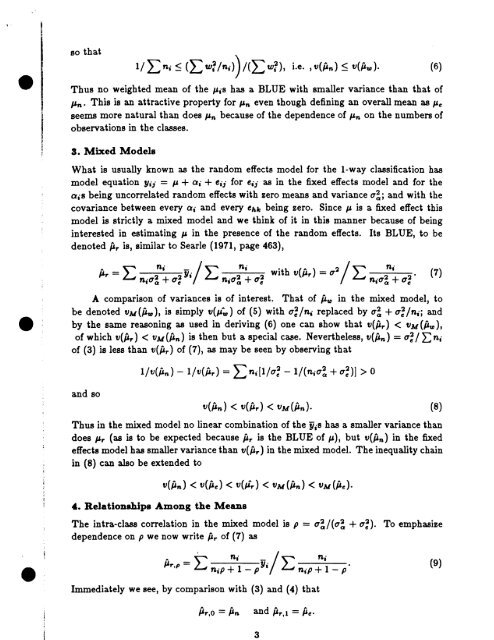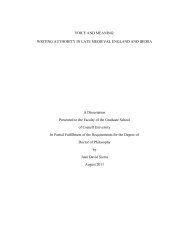On Means Estmated fran Preprint Nr. 58 - Cornell University
On Means Estmated fran Preprint Nr. 58 - Cornell University
On Means Estmated fran Preprint Nr. 58 - Cornell University
You also want an ePaper? Increase the reach of your titles
YUMPU automatically turns print PDFs into web optimized ePapers that Google loves.
3<br />
so that<br />
(6)<br />
Thus no weighted mean of the JjiS has a BLUE with smaller variance than that of<br />
Pn. This is an attractive property for Jjn even though defining an overall mean as Jje<br />
seems more natural than does Pn because of the dependence of Jjn on the numbers of<br />
observations in the classes.<br />
a. Mixed Models<br />
What is usually known as the random effects model for the 1-way classification has<br />
model equation 1/ij = p. + Oi + ei; for ei; as in the fixed effects model and for the<br />
OiS being uncorrelated random effects with zero means and variance u~; and with the<br />
covariance between every Oi and every ehk being zero. Since p. is a fixed effect this<br />
model is strictly a mixed model and we think of it in this manner because of being<br />
interested in estimating p. in the presence of the random effects. Its BLUE, to be<br />
denoted P.r is, similar to Searle (1971, page 463),<br />
A comparison of variances is of interest. That of P.w in the mixed model, to<br />
be denoted vM(P.w), is simply v(p.~) of (5) with u~/ni replaced by u~ + u~/ni; and<br />
by the same reasoning as used in deriving (6) one can show that v(P.r) < VM (P.w ),<br />
of which v(P.r) < VM(P.n) is then but a special case. Nevertheless, v(P.n) = u~/'Eni<br />
of (3) is less than v(P.r) of (7), as may be seen by observing that<br />
and so<br />
1/v(P.n)- 1/v(P.r) = E ni[1/u~- 1/(niO'~ + u~)] > 0<br />
Thus in the mixed model no linear combination of the Yis has a smaller variance than<br />
does P.r (as is to be expected because P.r is the BLUE of p.), but v(P.n) in the fixed<br />
effects model has smaller variance than v(P.r) in the mixed model. The inequality chain<br />
in (8) can also be extended to<br />
v(P.n) < v(P.e) < v(#'r) < VM(P.n) < VM(P.e)·<br />
(7)<br />
(8)<br />
4. Relationships Among the <strong>Means</strong><br />
The intra-class correlation in the mixed model is p = u~/(u~ + u~).<br />
dependence on p we now write P.r of (7) as<br />
To emphasize<br />
(9)<br />
Immediately we see, by comparison with (3) and (4) that<br />
A A d A A<br />
P.r,O = Jjn an Jjr,l = Jje•
















